Hassani S. Mathematical Physics: A Modern Introduction to Its Foundations
Подождите немного. Документ загружается.

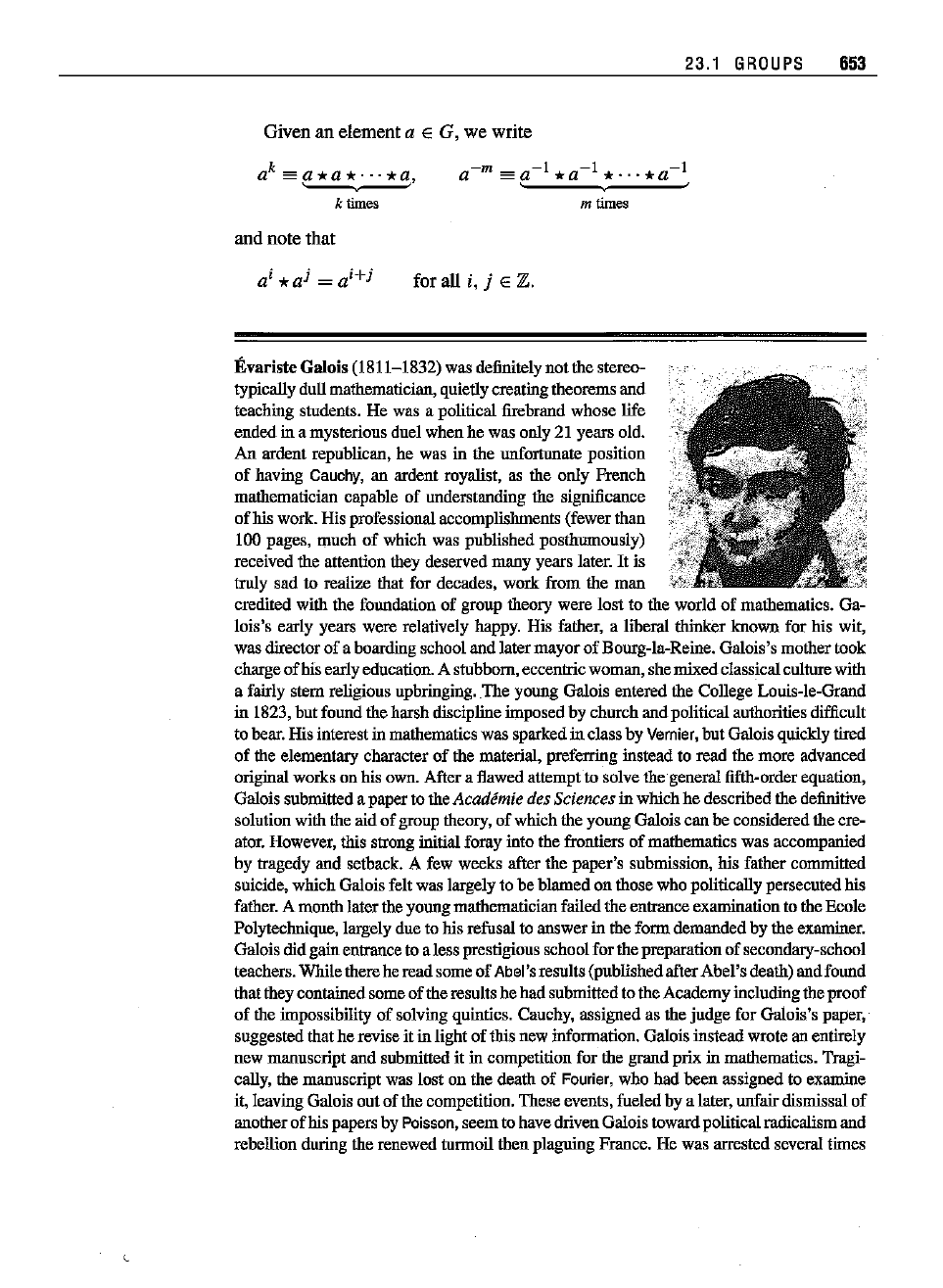
23.1
GROUPS
653
Given an element a E G, we write
a
k
=a*a*···*a,
'-,-'
k times
and
note
that
a-
m
es
a-I
*0-
1
*...
*a-
1.
m times
for all i, j E Z.
Evariste
Galois
(1811-1832)
was definitely
not
the stereo-
typicallydullmathematician, quietlycreatingtheorems
and
teaching students. He was a political firebrand
whose
life
ended
in a mysterious
duel
when
he was only 21
years
old.
An
ardent republican, he was in the unfortunate position
of
having Cauchy, an ardent royalist, as the
only
French
mathematician capable of understanding the significance
ofhis
work. His professional accomplishments
(fewer
than
100 pages,
much
of
which
was
published
posthumously)
received the attention they
deserved
many
years later.
It
is
truly
sad
to realize that for decades,
work
from
the
man
credited
with
the foundation
of
group theory
were
lost
to
the
world
of
mathematics. Ga-
lois's
early years
were
relatively happy. His father, a liberal thinker
known
for
his wit,
was director
of
a boarding school
and
later
mayor
of
Bourg-la-Reine,
Galois's
mother
took
charge
of
his earlyeducation.A stubborn,eccentric
woman,
she
mixed
classicalculture
with
a fairly
stem
religious upbringing..
The
young
Galois entered the College Louis-Ie-Grand
in 1823,
but
found the
harsh
discipline
imposed
by
church
and
political authorities difficult
to bear. His interest in mathematics was sparked
in class
by
Vernier,
but
Galois quickly tired
of
the elementary character
of
the material, preferring instead to
read
the
more
advanced
original works on his own.
After
a flawed
attempt
to
solve the-general fifth-order equation,
Galois submitted a
paper
to the
Academie
des
Sciences
in
which
he described the definitive
solution
with
the aid
of
group theory,
of
which
the
young
Galois
can
be consideredthe cre-
ator. However, this strong initial foray into the frontiers
of
mathematics was accompanied
by tragedy and setback. A few weeks
after
the
paper's
submission, his father
committed
suicide,
which
Galois felt was largely to be
blamed
on those
who
politically persecuted his
father. A
month
laterthe
young
mathematicianfailed
the
entrance examinationto the
Ecole
Poly
technique, largely
due
to his refusal to
answer
in
the
fonn
demanded
by the examiner.
Galois
did
gain
entranceto a lessprestigious school
for
the
preparation
of
secondary-school
teachers.
While
therehe
read
some
of
Abel's results
(published
after
Abel's
death)
andfound
that
theycontained
some
of
the results he
had
submittedto the
Academy
includingthe
proof
of
the impossibility
of
solving quintics. Cauchy, assigned as the
judge
for
Galois's
paper,
suggested that he revise it
in
light
of
this new information. Galois
instead
wrote an entirely
new manuscript
and
submitted it in competition for the
grand
prix
in mathematics. Tragi-
cally, the manuscript was
lost
on the
death
of
Fourier,
who
had
been
assigned to examine
it, leaving Galois
out
of
the
competition.
These
events,
fueled
by a later, unfairdismissal
of
another
of
his papers by
Poisson,
seem
to have drivenGalois towardpoliticalradicalism
and
rebellion during the
renewed
turmoil
then
plaguing France. He was arrested several times
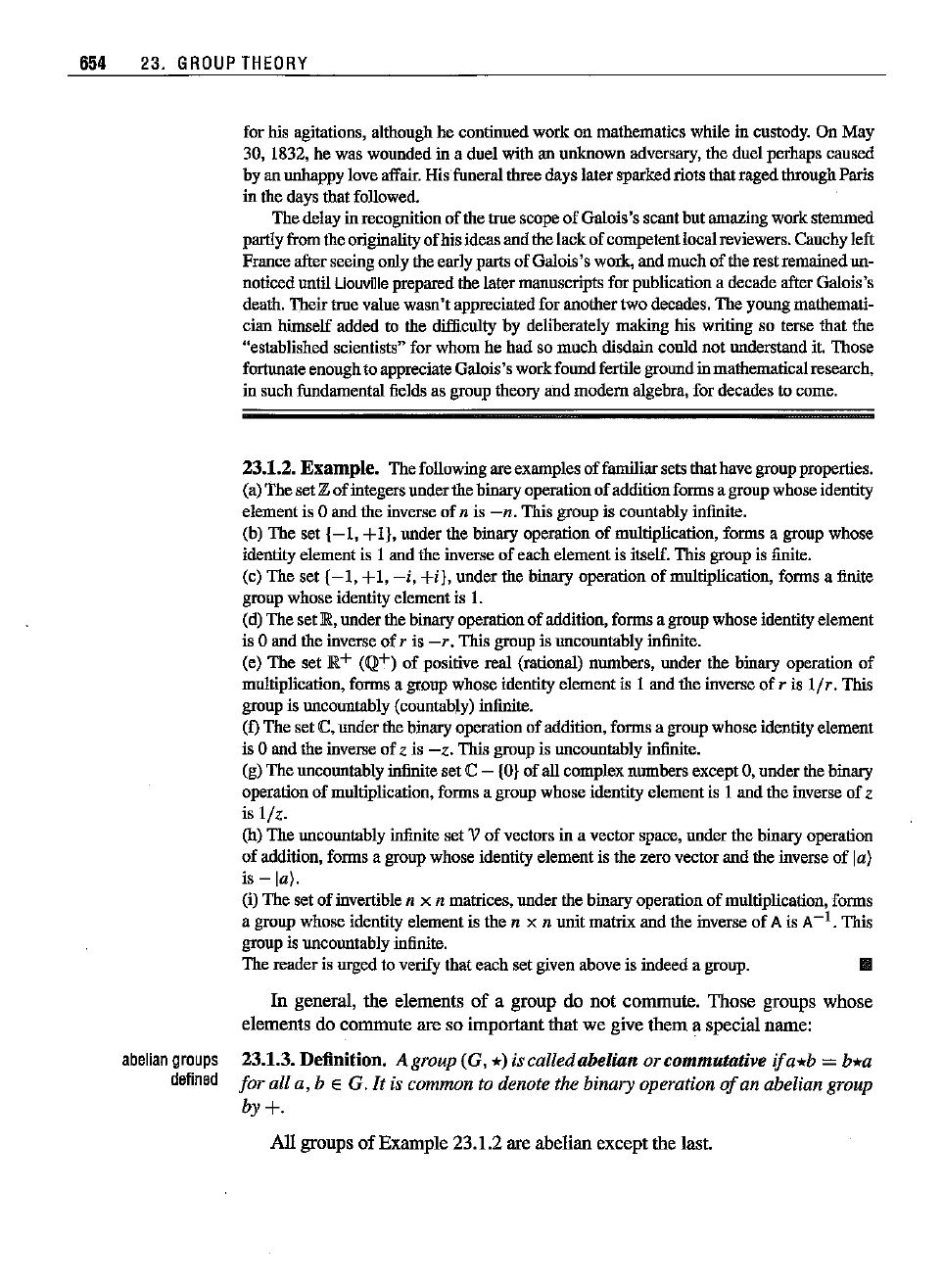
654
23.
GROUP
THEORY
for his agitations,althoughhe continuedwork on mathematicswhile in custody. On May
30, 1832, he was wounded in a
duel
with an
unknown
adversary, the
duel
perhaps caused
byanunhappyloveaffair. Hisfuneral threedayslatersparkedriotsthatragedthroughParis
in thedaysthatfollowed.
The
delayin recognition
of
the
true scope
of
Galois's
scant
but
amazing
work
stemmed
partlyfrom the originality
of
his
ideas
and
the
lack
of
competent
localreviewers. Cauchyleft
FranceafterseeingonlytheearlypartsofGalois's work,andmuchoftherestremainedun-
noticed until
Liouville
prepared the latermanuscripts for publication a decade after Galois's
death. Theirtrue value
wasn't
appreciated for
another
two decades.
The
young mathemati-
cian himself added to the difficnlty by deliberately making his wriring so terse that the
"established scientists" for
whom
he
had
so
much
disdain could
not
understand it. Those
fortunate enoughto appreciate
Galois's
work
found
fertile
ground
in mathematicalresearch,
in such fundamental fields as group theory
and
modem
algebra, for decades to come.
23.1.2.
Example.
Thefollowingareexamplesoffarniliarsetsthathavegroupproperties.
(a)
The
set
Z
of
integersunderthe binaryoperation
of
additionforms a groupwhoseidentity
element is 0
and
the
inverse
of
n is
-rtt,
This group is countably infinite.
(b) The set
I-I,
+Ij,
onder the binary operationof mnltiplication, forms a gronp wbose
identity elementis 1 and the inverse
of
each
element
is itself. This group is finite.
(c) The set
(-1,
+1,
-i,
+ij, under the binaryoperation ofmnltiplication, forms a finIte
group
whose
identity element is I.
(d)Theset
JR,
onderthebinarynperationofaddition,formsagronpwhoseidentityelement
is 0
and
the inverse
of
r is
-r.
This group isuncountably infinite.
(e) The setJR+
(1Ql+)
of positive real (rational) nnmbers, onder the binary operationof
multiplication, forms a group whose identity
element
is 1 and
the
inverse
of
r is
1/
r, This
groupis uncountably (countably) inlinite.
(f) The set C,
under
the binary operation
of
addition, forms a group whose identity element
is 0 and the inverse of
zis
-z.
This group is uncountably infinite.
(g)Theuncountablyinfiniteset
<C
-
(OJ
ofall complexnumbersexcept0, underthebinary
operation
of
multiplication, forms a group
whose
identity elementis 1
and
the inverse
of
z
is I/z.
(h)
The
uncountably infinite set V
of
vectors in a vector space, under the binary operation
of
addition, forms a group whose identity element is
the
zero vector
and
the inverse
of
la)
is
-tal.
(i) The set
of
invertible n x n matrices, under the binary operation
of
multiplication, forms
a group whose identity element is the
n x n
unit
matrix.
and
the
inverse
of
A is A
-1.
This
group is uncountably infinite.
The reader is urged to verify
that
each
set given above is indeed a group. II
abelian
groups
defined
In
general, the elements
of
a group do
not
commute.
Those
groups whose
elements do commute
are so important that we give them a special name:
23.1.3. Definition. A group (G, *) is calledabelian or commutative if
aeb
=
bea
for
all a,
bEG.
It is common to denote the binary operation
of
an abelian group
by+.
All
groups
of
Example 23.1.2 are abelian except the last.

23.1
GROUPS
655
23.1.4.
Example.
Let A be a vector potential that gives rise to a magneticfietd B. The
set of
transformations of A
that
give riseto the sameB is an
abelian
group.
In
fact,
such
transformations simply add the gradient of a function to A. The reader can check the
details. III
The reader
may
also verify that the set
of
invertible mappings f : S
-+
S,
i.e.,
the
set
of
transformations
of
S, is indeed a (nonabelian) group.
If
S has n
elements, this group is denoted by Sn and is called
the
symmetric
gronp
of
S. Sn
is a nonabelian (unless n ::; 2) finite group that
has
n! elements. An
element
g
of
S«
is usually denoted by two rows, the top row
being
S
itself-usually
taken to be
I, 2,
...
,
n-and
the
boltom
row
its image
under
g. For exannple, g sa (i
~
~
1)
is
an
element
of
S4 such that
g(l)
= 2, g(2) = 3, g(3) = 4,
and
g(4) =
I.
Consider two groups, the set
of
vectors in a plane
«x,
y),
+)
and the set
of
complex numbers (C, -t-),
both
under
addition. Although these are two different
groups,
the
difference is superficial. We have
seen
similar differences in disguise
in the context
of
vector spaces and the notion
of
isomorphism. The sanne notion
applies to group theory:
23.1.5. Definition.
Let
(G,
*) and (H, 0) be groups. A homomorphism f :
G-+
H is a map such that
symmetric
or
permutation
group
homomorphism,
isomorphism,
and
automorphism
f(a
*b)
=
f(a)
0
feb)
Va,b
E G.
trivial
homomorphism
general
linear
group
An isomorphism is a homomorphism that is also a bijection. Two groups are
isomorphic, denoted by
G
~
H,
if there is an isomorphism f : G
-+
H.
An
isomorphism
of
a group onto itselfis called an automorphism.
Aninmnediateconsequence
of
this definitionis
thatf(eG)
= en and
f(g-l)
=
[f(g)]-l
(see Problem 23.9).
23.1.6.
Example.
Let G be anygroup and (I} the multiplicativegroupcousistiugof the
singlenumber
1.
It
isstraightforwardto showthat1 :G --+ (I}, givenby (theoulyfunction
available!)
l(g)
= I for all g
EGis
a homommphism.This homomorphismis calledthe
trivial(orsometimes, symmetric)
homomorphism.
II
The establishment
of
isomorphism f :
1R
2
-+
C between
«x,
y),
-l-),
and
(C, +) is trivial: Just write
f(x,
y) = x +
iy.
A less trivial isomorphism is
the
exponential map, exp :
(JR,
+)
-+
(JR+,.).
The
reader
may
verify that this is a
homomorphism (in particular, it
maps
addition to multiplication)
and
that it is
one-to-one. We have noted that
the
set
of
invertible
maps
of
a set forms a group.
A very important special case
of
this is
when
the
set is a vector space V and
the
maps are all linear
23.1.7. Box. The general linear group
of
a vector space V, denoted by
GL(V),
is the set
of
all invertible endomorphisrns
ofV.
In particular, when
V= C",weusuallywrite
GL(n,
iC)insteadofGL(iC") withsimilarnotation
forlR.
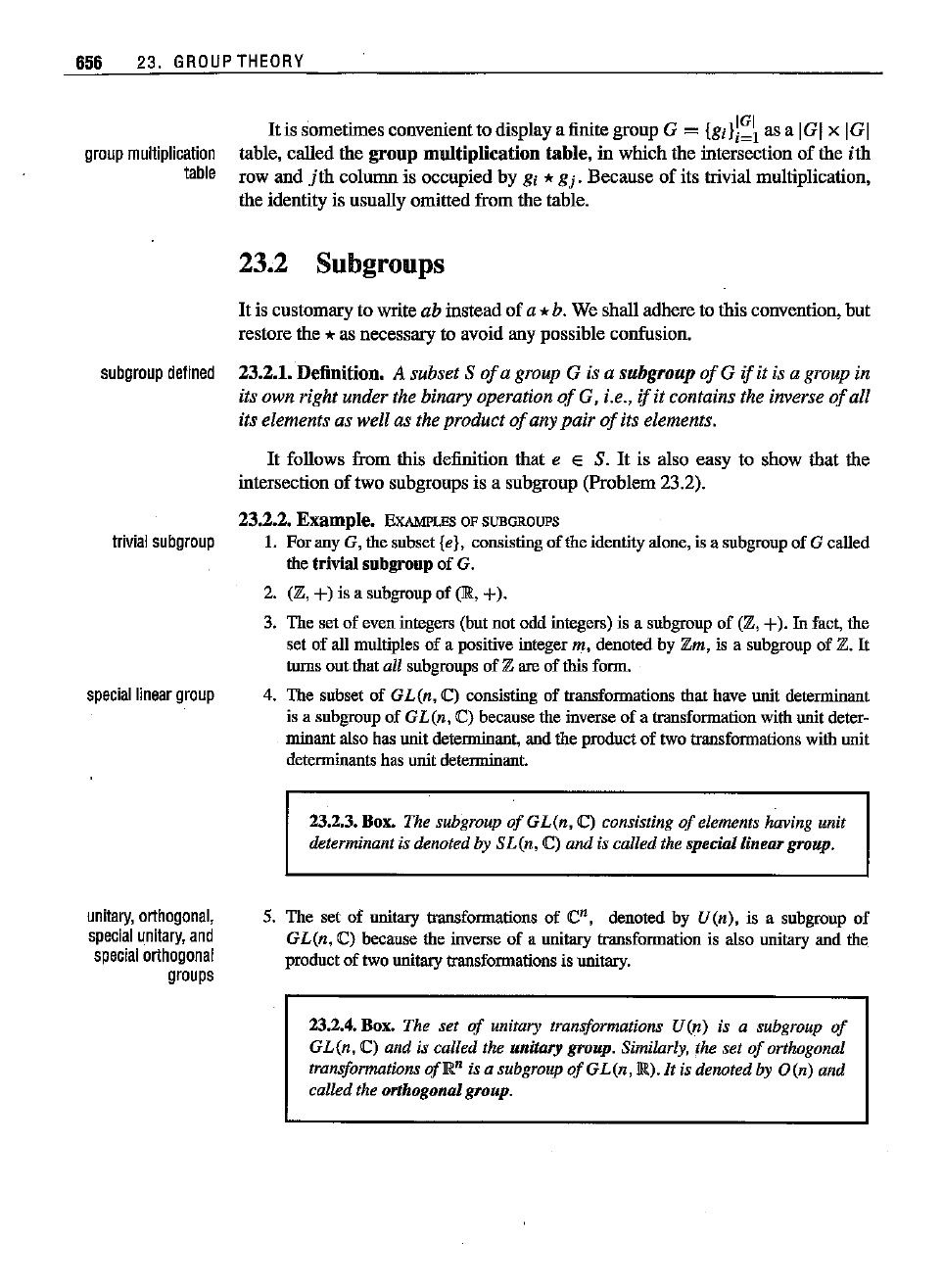
656 23.
GROUP
THEORY
group
multiplication
table
It
is sometimes convenientto displaya finite group G =
{g;})~\
as a IGI x IGI
table, called the
grnup
multiplication
table,
in which the intersection
of
the
ith
row
and
jth
column is occupied by gi *
gj.
Because
of
its trivial multiplication,
the identity is usually omitted from the table.
23.2 Subgroups
It
is customary to write ab instead
of
a *b. We shall adhere to this convention, but
restore the *as necessary to avoid any possible confusion.
subgroup
defined
23.2.1. Definition. A subset S
of
a group G is a
subgroup
of
G ifit is a group in
its
own
right
under the binary operation
of
G, i.e., ifit contains the inverse
of
all
its elements as wellas the
product
of
any
pair
of
its elements.
It
follows from this definition that e E S.
It
is also easy to show that the
intersection
of
two subgroups is a subgroup (Problem 23.2).
23.2.2.
Example.
ExAMPLES OF SUBGROUPS
trivial
subgroup
I.
ForanyG, thesubset
{e},
consistingof theidentityalone,isa subgroup
ofG
called
the trivial subgroup of G.
2.
(:I:,-t-) is a subgroupof (R,
+).
3. The set of evenintegers(butnot odd integers)is a subgroupof (:I:,+). In fact, the
set
of
all multiples
of
a positive integer m, denoted by Zm, is a subgroup
of
Z.
It
turnsout thatall subgroupsof Z areof thisform.
special
linear
group 4. The subset of
GL(n,
C) consisting of transformations that have unit determinant
is a subgroup
of
GL(n,
C)
because the inverse
of
a transformation with unit deter-
minant alsohas unit determinant,and the productof twotransformations with unit
determinants has unit determinant.
23.2.3.Box. The subgroup
of
GL(n, C) consisting
of
elements having unit
determinant is denoted
try
SL(n, C) and is called the special linear group.
unitary,
orthogonal,
special
unitary,
and
speciai
orthogonal
groups
5. The set of uoitary transformations of C", denoted by
U(n),
is a subgroup of
GL(n, C) because the inverse
of
a unitary transformation is also unitary and the
product
of
two unitary transformations is unitary.
23.2.4.
Box. The set
of
unitary transformations U(n) is a subgroup
of
GL(n, iC) and is called the unitary group. Similarly,the set
of
orthogonal
transformations
of~n
is a subgroup
ofGL(n,
~).
It is denotedby O(n) and
calledthe orthogonal group.
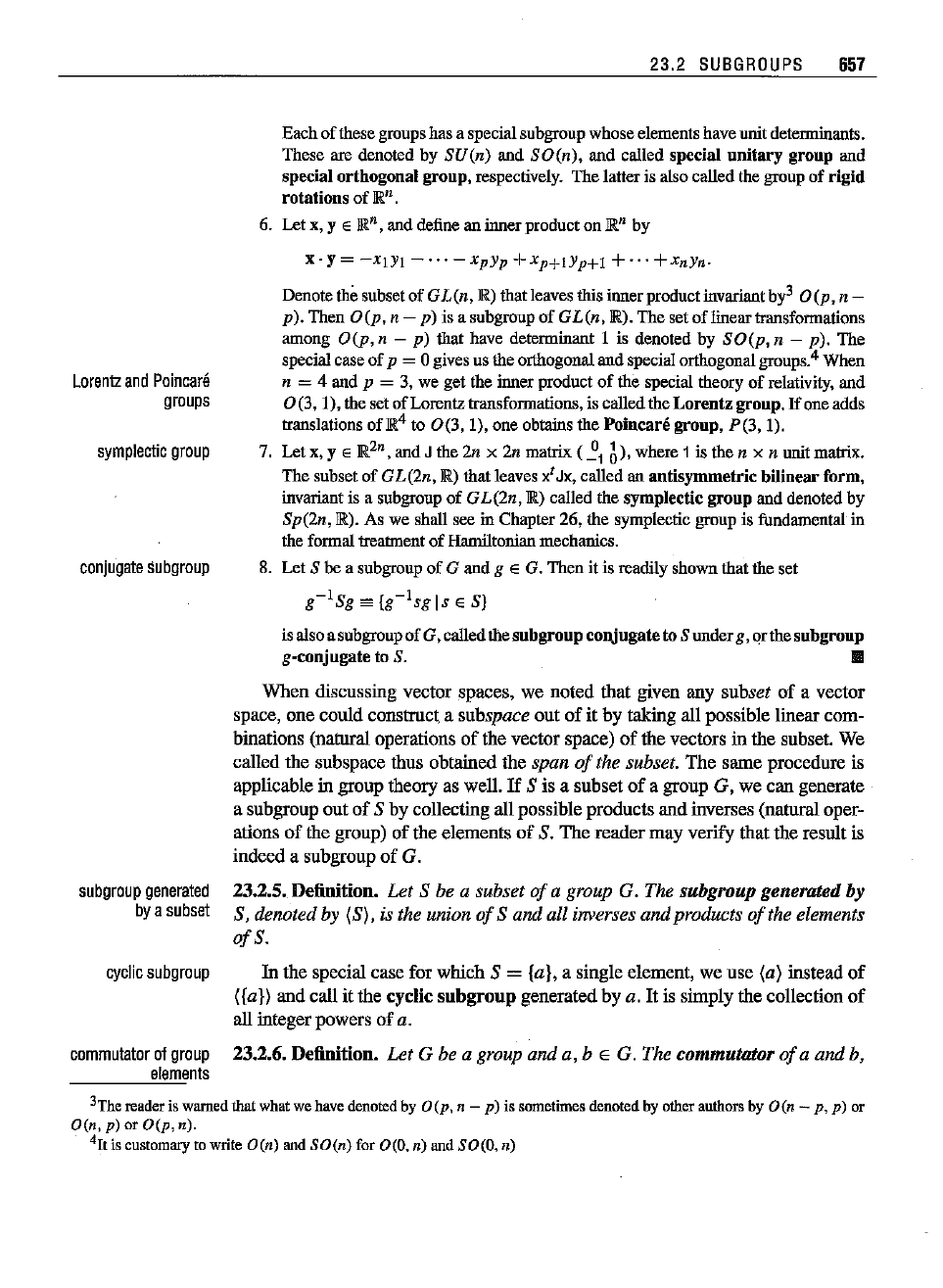
23.2 SUBGROUPS 657
Lorentz
and
Poincare
groups
symplectic
group
conjugate
Subgroup
Eachofthesegroupshasa specialsubgroupwhoseelementshaveunitdeterminants.
These are denoted by
SU(n) aod SO(n), aod called special unitary group aod
specialorthogonalgroup,respectively.
The
latter is also called the group
of
rigid
rotations
of
R".
6. Let x, YE
JR
n
,
and define an inner product on
R"
by
x- Y=
-XIYl
-
...
-
xpYp
+ Xp+lYp+l + ...
+xnYn·
Denote
the
subset
of
G
L(n,
JR)
thatleaves this innerproductinvariantb
y3
0
(p,
n -
pl. Then O(p, n - p) is a subgroupof GL(n, R). The setoflineartransformations
among
O(p, n - p) that have determinaot t is denoted by SO(p, n - pl. The
specialcaseof p = 0 givesus theorthogonalandspecialorthogonalgroups."When
n = 4 and p = 3, we
get
the inner product
of
the special theory
of
relativity, and
0(3,
I), the set of Lorentztransformations, is calledthe Lorentzgroup.
If
one adds
traoslatioos
ofli
4
to
0(3,
1), one obtalosthe Poincare group, P(3, 1).
7. Let x, y E ]R2n,and J the 2n x 2n matrix
(~1
~),
where 1 isthe n x n unit matrix.
The
subset
of
GL(2n,
JR)
that
leaves x
t
Jx, called an antisymmetric bilinearform,
invariantis a subgroupof GL(2n,
Ii)
calledthe symplectic group aod denotedby
Sp(2n,R). As we shall see in Chapter26,the symplecticgroup is fundamental in
the formal treatment
of
Hamiltonian mechanics.
8. Let S bea subgroupof G aod g E G. Theo it is readilyshownthatthe set
g-lSg
ea
(g-lsgls
E S)
subgroup
generated
bya subset
is also a subgroup
of
G. calledthe subgroupconjugateto
Sunder
g. or-thesubgroup
g.conjugate to
S. III
When
discussing vector spaces, we noted that given any subset
of
a vector
space, one could construct. a
subspace out
of
it by taking all possible linear com-
binations (natnra! operations
of
the vector space)
of
the vectors in the subset. We
called the subspace thus obtained the
span
of
the subset.
The
same procedure is
applicable in group theory as well.
If
S is a subset
of
a group G, we can generate
a subgroup out
of
S by collecting all possible products
and
inverses (natural oper-
ations
of
the group)
of
the elements
of
S.
The
reader
may
verify that the result is
indeed a subgroup
of
G.
23.2.5. Definition. Let S be a subset
of
a group G. The subgroup generated by
S, denoted by (S), is the union
of
S and all inverses and products
of
the elements
ofS.
In the special case for which S =
{aj,
a single element, we use (a) instead
of
({aJ) and call it the cyclic
subgroup
generated by a.
It
is simply the collection
of
all integer powers
of
a.
23.2.6. Definition. Let G be a group and a,
bEG.
The commutator
of
a and b,
cyclic
subgroup
commutator
of
group
elements
3The reader is warned that what we have denoted by
O(p,
n -
p)
is sometimes denotedbyother authors by O(n - p, p) or
Otn,
p) or
O(p,
n).
4
It
is customary to write
O(n)
and SO(n) for
0(0.
n) and SO(O.n)
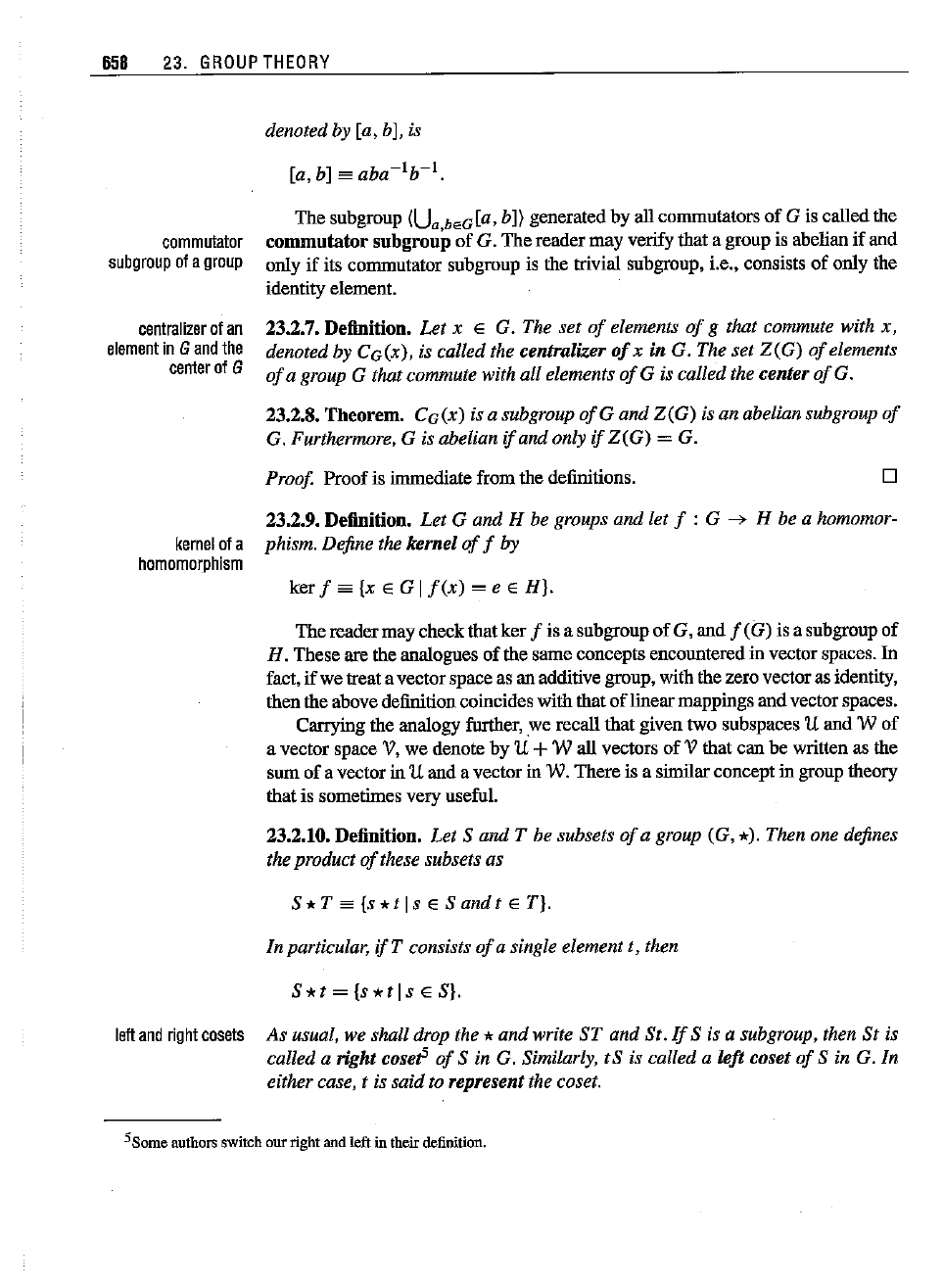
658
23.
GROUP
THEORY
denoted by [a, b], is
[a, b]
es
aba-1b-
1
.
commutator
subgroup
of
a
group
centralizer
ofan
element
in
G
and
the
center
ofG
The subgroup
(Ua
bEG[a,b]) generatedby all commutalorsof G is calledthe
commutatorsubgroup of G. Thereader may verifythat a group is abeliauif aud
only if its commutator subgroupis the trivial subgroup,i.e., consists of only the
identityelement.
23.2.7.Definition.
Let x E G. The set
of
elements
of
g that commute with x,
denoted by G
G(x), is called the centralizer
of
x in G. The set Z
(G)
of
elements
of
a group G that commute with all elements
of
G is called the center
of
G.
23.2.8.Theorem. GG(x) is a subgroup
ofG
and
Z(G)
is an abelian subgroup
of
G. Furthermore, G is abelian
ifand
only
if
Z(G)
= G.
Proof. Proofis immediatefrom the definitions. D
23.2.9.Definition.
Let
G and H be groups and let f : G --> H be a homomor-
kernel
ofa phism. Define the kernel
of
f by
homomorphism
ker f sa {x E G I
f(x)
= e E
H}.
Thereadermaycheckthatker f is a subgroupofG, aud f (G) isa subgroupof
H. Theseare the aualoguesof the sameconceptsencounteredin vectorspaces.
In
fact,if wetreatavectorspaceas auadditivegroup,withthezerovectorasidentity,
thenthe abovedefinitioncoincideswiththatof linearmappingsaudvectorspaces.
Carryingthe aualogyfurther,we recall that giventwo subspaces
11
aud W of
a vector space V,we denote by
11
+W all vectors of V that cau be writtenas the
sumof a vectorin
11
audavectorin W. There is a similarconceptin grouptheory
that is sometimesveryuseful.
23.2.10.Definition.
Let
Sand
T be subsets
of
a group (G, *). Then one defines
the product
of
these subsets as
In particular,
if
T consists
of
a single element t, then
SH
=
{sHls
E S}.
left
and
right
cosets
As usual, we shall drop the *and write
ST
and St.
If
S is a subgroup, then St is
called a right coseP
of
Sin
G. Similarly,
tS
is called a left coset
of
Sin
G. In
either case, t is saidto representthe coset.
5Some
authors
switchour
right
andleftintheir
definition.
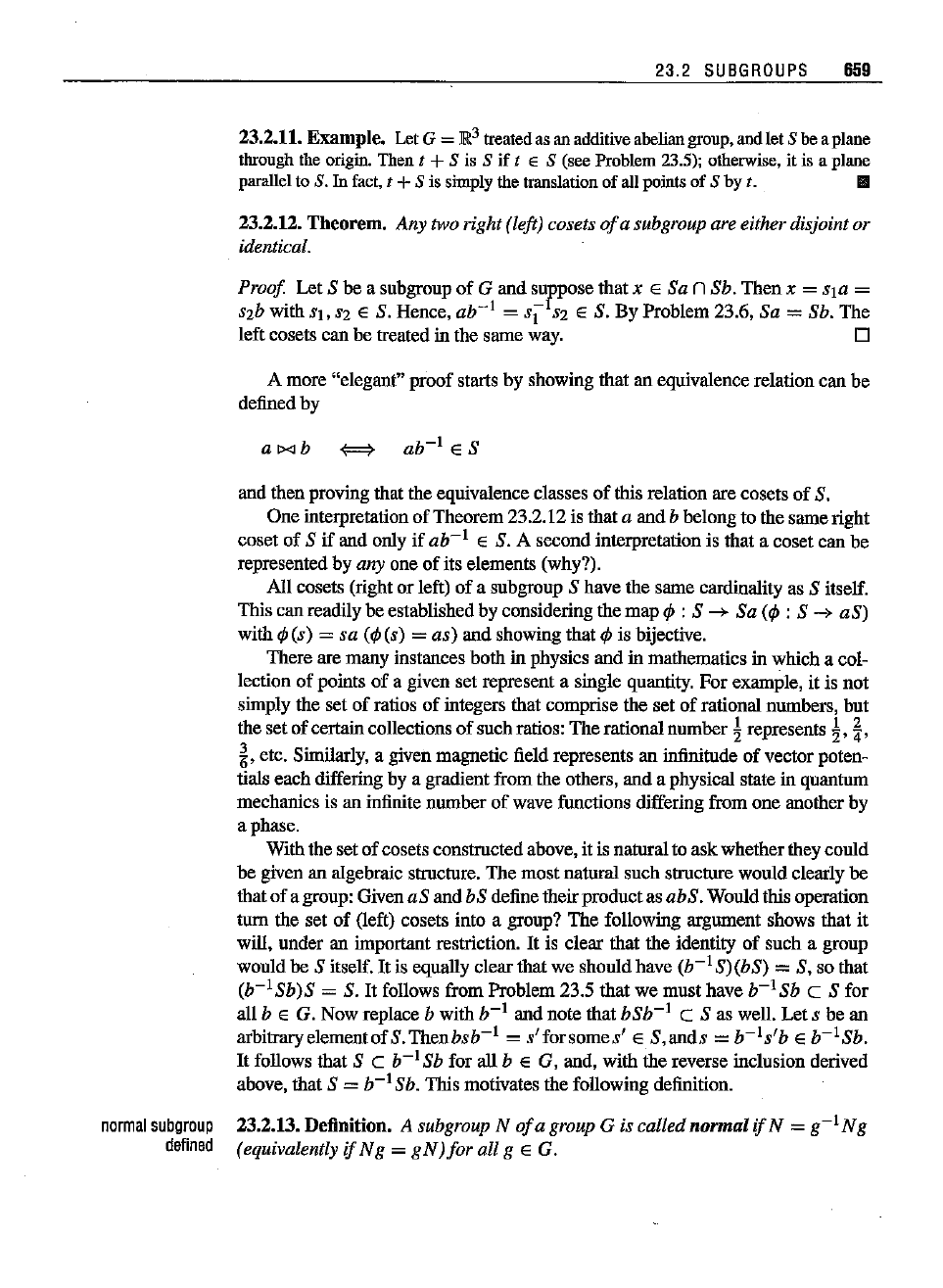
23.2
SUBGROUPS
659
23.2.11.
Example.
LetG =
JR.3
treatedas an additiveabeliangroup,andlet Sbeaplane
through the origin.Then
t + S is S if t E S (see Problem 23.5); otherwise,it is a plane
parallelto
S. Iu fact,t +S is simplythe translationof allpointsof S by t.
III
23.2.12.
Theorem.
Any two right (left) cosets
of
a subgroup are either disjoint or
identical.
Proof
Let S be a subgroup
of
G and sUfPose that x E Sa nSb. Thenx = Sla =
S2bwith
Sl,
S2
E S. Hence,
ab:"
=
sl
S2
E S. By Problem 23.6, Sa =Sb. The
left cosets can be treated in the same way.
D
A more "elegant"
proof
starts by showing that an equivalence relation can be
defined by
a
[xl
b
{==}
ab-
I
E S
and then proving that the equivalence classes
of
this relation are cosets
of
S.
One interpretation
of
Theorem 23.2.12 is that a and b belong to the sameright
coset
of
S if and only if
ab-
I
E S. A second interpretation is that a coset can be
represented by
anyone
of
its elements (why?).
All cosets (right or left)
of
a subgroup S have the same cardinality as S itself.
This can readily be established by considering the
map
</>
: S
-+
Sa
(</>
: S
-+
as)
with
</>(s)
=sa
(</>(s)
=
as)
and showing that
</>
is bijective.
There are many instances both in physics and in mathematics in which a col-
lection
of
points
of
a given set represent a single quantity.
For
example, it is not
simply the set
of
ratios
of
integers that comprise the set
of
rational numbers, but
the set
of
certaincollections
of
suchratios;
The
rationalnumber
~
represents
~, ~,
~,
etc. Similarly, a given magnetic field represents an infiuitude
of
vector poten-
tials each differing by a gradient from the others, and a physical state in quantum
mechanics is an infiuite number
of
wave functions differing from
one
another by
a phase.
With the set
of
cosets constructed above, it is naturalto ask whetherthey could
be given an algebraic structure. The mostnatural such structure would clearly be
that
of
a group; Given
as
and
bS
define their productas
abS.
Wonldthis operation
turn the set
of
(left) cosets into a group?
The
following argument shows that it
will, under an important restriction.
It
is clear that the identity
of
such a group
would be S itself.
It
is equally clearthat we shonld have
(b-
1
S)(bS)
= S, so that
(b-ISb)S
= S.
It
follows from Problem 23.5
that
we must have
b-ISb
c S for
all
bEG.
Now replace b
withb-
I
and note
thatbSb-
1
c S as well.
Lets
be an
arbitraryelementofS.Thenbsb-
1
=
s'farsomes'
E
S,ands
=
b-Is'b
E
b-1Sb.
It
follows that S C
b-
I
Sb for all
bEG,
and, with the reverse inclusion derived
above, that S
=
b-
I
Sb, This motivates the following definition.
normal
subgroup
23.2.13. Definition, A subgroup N
ofagroup
G is called
normal
ifN =
g-I
Ng
detined
(equivalently ifNg = g
N)
for
all g E G.
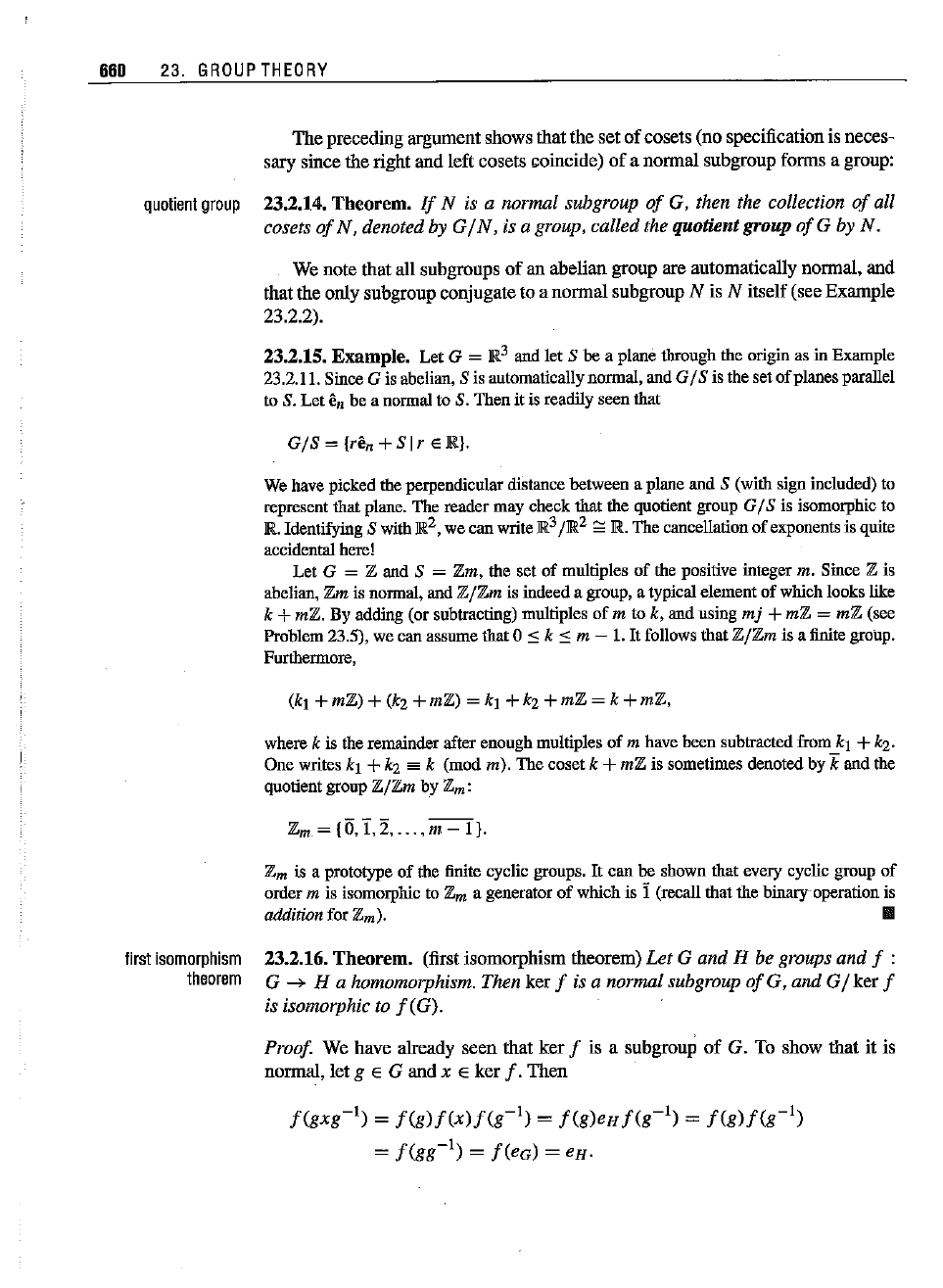
660 23.
GROUP
THEORY
The preceding argument shows that the set of cosets (no specification is neces-
sary since the right and left cosets coincide)
of
a normal subgroup forms a group:
quolienl
group
23.2.14.
Theorem.
If
N is a normal subgroup
of
G, then the collection
of
all
cosets
of
N, denoted by
GIN,
is a group, called the quotientgroup
of
G by N.
We note that all subgroups
of
an abelian group are automatically normal. and
that the only subgroup conjugate to a normal subgroup
N is N itself(see Example
23.2.2).
23.2.15. Example. Let G =
JR.3
andlet S be a planetbroughthe originas in Example
23.2.11. SinceG isabelian, S isautomatically normal,and
GIS
isthesetofplanesparallel
to S. Let
ell
be anormalto S. Thenitis readilyseen that
GIS
=
{re
n
+
Sir
E
JR.}.
Wehavepickedthe
perpendicular
distance
betweena planeandS (withsign
included)
to
represent
that
plane.The
reader
may check
that
the quotientgroup G/ S is isomorphicto
R, Identifying S with
JR.
2,
wecanwrite
JR.3
jJR.2
:::R. Thecancellation of
exponents
isquite
accidental
here!
Let G = Z andS = Zm, the set of multiples of thepositive
integer
m. Since Z is
abelian,
Zmis
normal,
andZ/Zm is indeeda
group,
atypicalelementof whichlookslike
k +mZ. Byadding(or subtracting) multiples of m to k, andusing
mj
+
mZ
=
mZ
(see
Problem
23.5), wecanassumethat0 .S k ::;m -
I.
It
follows
that
ZjZm
is a
finite
group.
Furthermore,
(kt
+mZ)
+(k2
+mZ)
= kl
+k2
+mZ
=
k+mZ,
where
k is the
remainder
after
enough
multiples
of mhavebeen
subtracted
from
kl +k2.
One
writes
kl +k2
==
k (mod m). Thecosetk +mZ is sometimes
denoted
bykandthe
quotientgroup
ZjZm
by Zm:
Zm
=
to,
T,
2,
... ,m
-I}.
Zm
is a
prototype
of the finitecyclic
groups.
Itcan be shown
that
everycyclic
group
of
order
m is
isomorphic
to Zm a
generator
of whichis j (recallthatthe
binary-operation
is
addition
for Zm).
III
first
isomorphism
lheorem
23.2.16.
Theorem.
(first isomorphism theorem) Let G and H be groups and f :
G
---*
H a homomorphism. Then ker f is a normal subgroup
of
G, and GIker f
is isomorphic to f
(G).
Proof
We have already seen that ker f is a subgroup
of
G. To show that it is
normal, let
g E G and x E ker
f.
Then
f(gxg-
1
)
=
f(g)f(x)f(g-l)
=
f(g)eHf(g-l)
=
f(g)f(g-l)
=
f(gg-l)
=
f(eG)
= en-
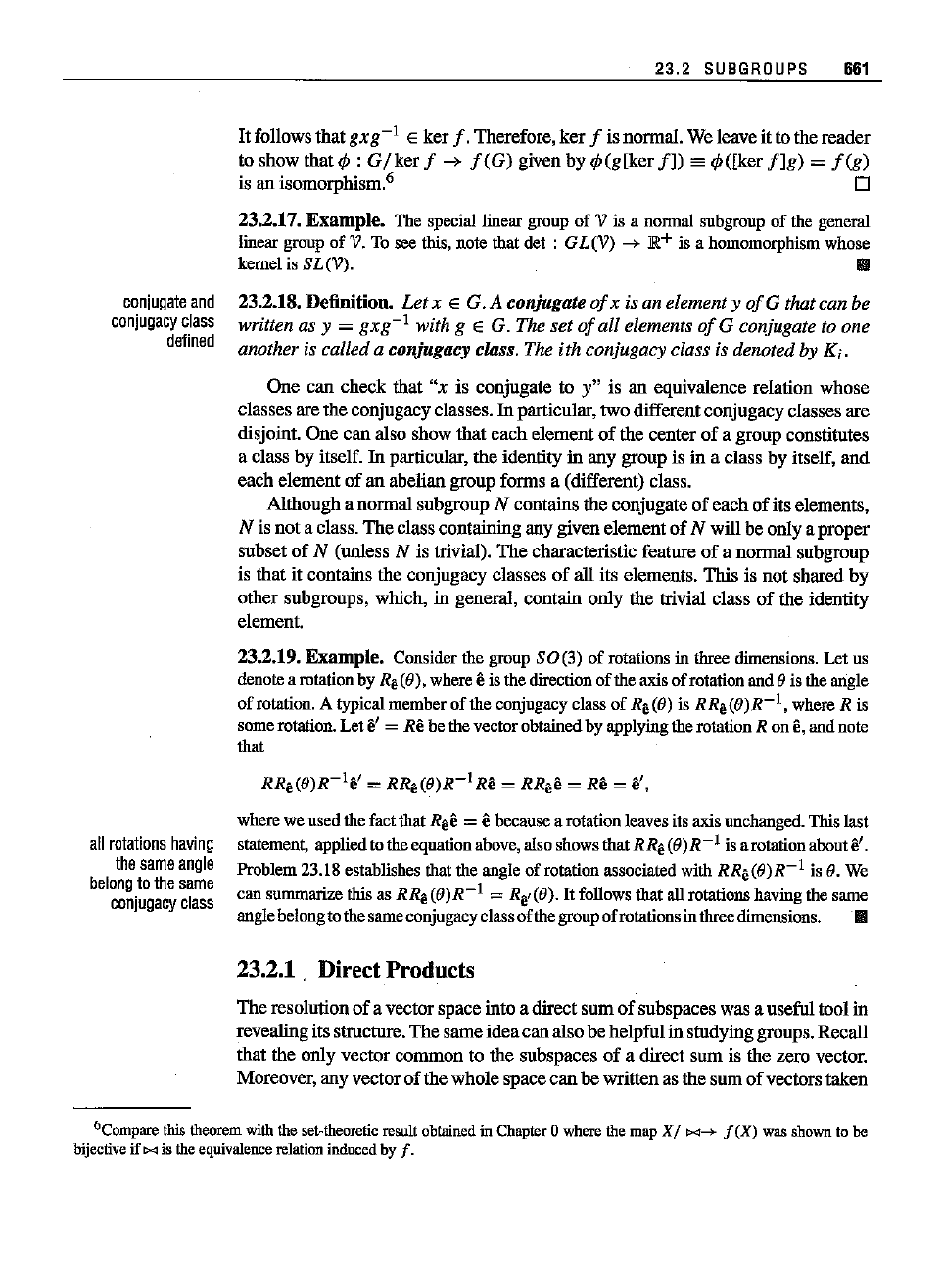
conjugate
and
conjugacy
class
defined
all
rotations
having
thesame
angle
belong
tothesame
conjugacy
class
23.2
SUBGROUPS
661
It
follows that
gxg-
1
E
ker
f.
Therefore,
ker
f
isnonnal.
We
leaveitto
the reader
to show that
<p
:
G/ker
f
--?
f(G)
given by <p(g[ker fJ)
==
<p([ker
f]g)
=
f(g)
is an isomorphism." D
23.2.17.
Example.
The special linear group uf V is a uonnal subgroup of the general
linear
group
of V. Tosee this,Dotethatdet :
GL(V)
--+ jR+ is a
homomorphism
whose
kemet is
SL(V).
III
23.2.18. Definition.
Let
x E G. A conjugate
of
x is an element y
of
G that can be
written as
y =
gxg-
1
with g E G. The set
of
all elements
ofG
conjugate to one
another is called a conjugacy class. The ith conjugacy class is denoted
by Ki,
One can check that "x is conjugate to y" is an equivalence relation whose
classes are the conjugacyclasses.
In
particular, two differentconjugacy classes are
disjoint. One can also show that
each
element
of
the center
of
a group constitutes
a class by itself.
In
particular, the identity in any group is in a class by itself.
and
each element
of
an abelian group forms a (different) class.
Although a normal subgroup
N contains the conjugate
of
each
of
its elements,
N is not a class.
The
classcontaining any given element
of
N will be ouly a proper
subset
of
N (unless N is trivial).
The
characteristic feature
of
a normal subgroup
is that it contains the conjugacy classes
of
all its elements. This is
not
shared by
other subgroups, which, in general, contain only the trivial class
of
the identity
element.
23.2.19.
Example.
Considerthe group SO(3) of rotations in three dimensions. Let us
denote
a
rotation
by
R~
(f),
where
e is the
direction
oftheaxisof
rotation
and
()
is theangle
ofrotation.A typicalmemberoflbe conjngacyclass of Re(B) is
RRe(B)R-
1,
whereR is
some
rotation.
Let
~
= Re bethevector
obtained
by
applying
the
rotation
R one,andnote
tbat
RRe(B)R-
1.,
=
RRe(B)R-
1
R.
= RR
e•
=
R.
=
.',
where
weusedthefact
that
R@e
= ebecausea
rotation
leavesitsaxis
unchanged.
Thislast
statement,
applied
tothe
equation
above,alsoshows
that
RR@(f))R-
1
isarotation
about
S'.
Problem23.18 establishestbat the angleof rotationassociatedwith RR
e(6)R-
1
is 6. We
can summarizethisas
RR
e(6)R-
1
= Re,(B).
It
followstbat all rotationshavingthe same
anglebelongtothesameconjugacyclass
of
the
group
of
rotationsin
three
dimensions. II
23.2.1 Direct Products
The resolution
of
a vectorspace into a direct
sum
of
subspaces was a useful tool in
revealingits structure.
The
same
idea
can also be helpfulin studyinggroups. Recall
that the only vector common to the subspaces
of
a direct sum is the zero vector.
Moreover, any vector
of
the whole space
can
be writtenas the sum
of
vectors taken
6Compare
this
theorem
withtheset-theoretic
result
obtained
in
Chapter
0 wherethemapXI
Ex;-+
f(X)
wasshownto be
bijective
if
Ex; is the
equivalence
relation
induced
by
f.

662 23.
GROUP
THEORY
from the subspaces of the direct sum. Considering a vector space as a (abelian)
group, with zero as the identity and summation as the group operation, leads to
the notion of direct product.
internal
direct
product
of
groups
external
direct
product
of
groups
23.2.20. Definition. A group G is said to be the direct product
of
two
of
its sub-
groups
HI and H2, and we write G = HI X H2, if
1. all elements
of
HI commute with all elements
of
H2;
2. the group identity is the only element common to both
HI and H2;
3. every g E G can be written as g =
hlh2
with hI E HI and h2 E H2.
It
follows from this definition that hI and h2 are unique, and HI and H2 are
normal. This kind of direct product is sometimes called internal, because the
"factors" HI and
H2are chosen from inside the group G itself. The external direct
product results when we take two unrelatedgroups and make a group out of them:
23.2.21. Proposition.
Let
G and H be groups. The Cartesian product G x H,
called the external direct product
of
G and H, can be given a group structure by
(g, h)
*is'.
h')
es (gg', hh').
Furthermore,G
~
Gx{eH},H
~
{eG}xH,GxH
~
HxG,andtowithinthese
isomorphisms, G x H is the internal directproduct
ofG
x {eH} and leG} x H.
The proof is left for the reader.
Niels
Henrik
Abel
(1802-1829)was the second
of
sevenchil-
dren,
son of a
Lutheran
minister
witha small
parish
of Nor-
wegian
coastal
islands.
In school he
received
only
average
marks
at
first,
butthenhis
mathematics
teacher
was
replaced
by a
man
only seven years older than Abel.
Abel's
alcoholic
father
diedin 1820, leavingalmostno
financial
support
for
his young
prodigy,
who
became
responsible
for
supporting
his
mother
and
family.
His
teacher,
Holmboe,
recognizing his
talent
for
mathematics,
raisedmoney
from
his colleaguesto
enable
Abel to
attend
Christiania
(modemOslo)
University.
He
entered
the
university
in 1821,10
years
after
the
university
was
founded,
and
soon
proved
himself
worthy
ofhis
teacher's
accolades.
Hissecond
paper,
for
example,
contained
the
first
example
ofa solution toan
integral
equation.
Abel
then
received
atwo-year
govemmenttravel
grant
and
journeyed
to
Berlin,
where
he
metthe
prominentmathematician
Crelle,
whosoon
launched
what
wastobecomethe
leading
Gennan
mathematical
journal
of
the
nineteenth
century,
commonly
calledCrelle's
Journal.
From
the
start,
Abel
contributed
important
papers
to Crelle's
Journal,
including
a classic
paper
on
power
series,
thescopeof which
clearly
reflects
his
desire
for
stringency.
Hismost
important
work,
also
published
in
that
journal,wasalengthy
treatment
ofelliptic
functions
in
